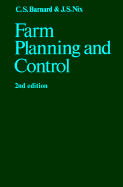Book contents
- Frontmatter
- Contents
- Notice to readers
- Preface to the first edition
- Preface to the second edition
- Selected metric conversion factors
- Part I The organisation of resources
- Part II The organisation of enterprises
- 6 An introduction to enterprise organisation
- 7 Livestock yield and fixed costs
- 8 Yield, variable costs and optimal feed conversion
- 9 The selection of feedstuffs
- 10 The influence of season on livestock production
- 11 The provision of replacements
- 12 Crops and cropping
- Part III The combination of enterprises
- Part IV The control of resources and enterprises
- Selected further reading
- Index
9 - The selection of feedstuffs
Published online by Cambridge University Press: 01 June 2011
- Frontmatter
- Contents
- Notice to readers
- Preface to the first edition
- Preface to the second edition
- Selected metric conversion factors
- Part I The organisation of resources
- Part II The organisation of enterprises
- 6 An introduction to enterprise organisation
- 7 Livestock yield and fixed costs
- 8 Yield, variable costs and optimal feed conversion
- 9 The selection of feedstuffs
- 10 The influence of season on livestock production
- 11 The provision of replacements
- 12 Crops and cropping
- Part III The combination of enterprises
- Part IV The control of resources and enterprises
- Selected further reading
- Index
Summary
If only one type of feedstuff were available to the livestock producer, he would (as we saw in the previous chapter) simply be concerned with how much of it to feed. As he is, in practice, confronted with a wide range of alternative feeds, he has also to decide which of them to use and this may include choosing between buying foods such as barley, beans and hay, as opposed to growing them on the farm. The selection is widest with grazing livestock, for there are both concentrated and bulky foods from which to choose. As the latter are commonly grown on the farm and there are alternative methods of producing them–for example, grass conserved as hay or as silage, or kale unthinned and grazed direct or thinned and cut and carted to the cattle–selecting the most appropriate method of production adds to the size of the problem.
Economic principles
The basic problem facing the producer is to select that food or combination of foods which provides a given livestock output at least cost. Two examples, each involving only two foods at a time, are given in Table 9.1. The first shows different combinations of soya-bean meal and corn producing 0.45 kg gain on broilers initially weighing 0.68 kg. The first ration is relatively high in corn but low in soya-bean meal. As the latter is increased in the ration, the amount of corn is reduced, but by smaller and smaller quantities for each successive addition of soya-bean meal.
- Type
- Chapter
- Information
- Farm Planning and Control , pp. 203 - 225Publisher: Cambridge University PressPrint publication year: 1980



